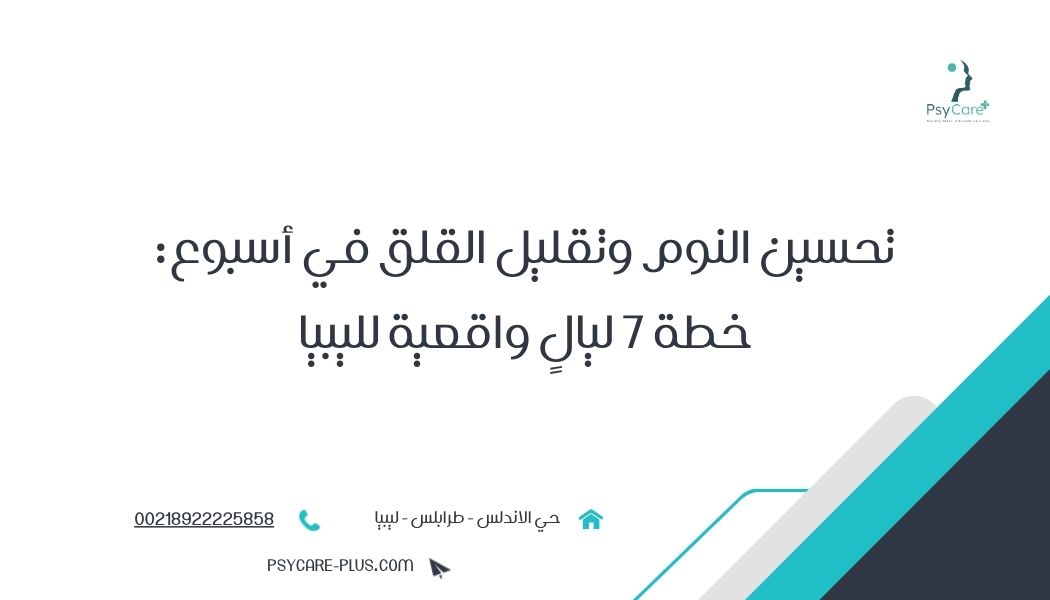Better Sleep & Less Anxiety in 7 Nights: A Realistic One-Week Plan for Libya
Smart Wind-Down + Light/Caffeine Timing + 4–6 Breathing + Scheduled Worry Time

Better Sleep & Less Anxiety in 7 Nights: A Realistic One-Week Plan for Libya
Note: Educational guide—not an emergency service. For immediate risk, contact local emergency services. For structured care, book online via Therapists or download PyCare Plus on Google Play. Learn more: Who We Are — Blog — Contact Us.
Introduction
Anxiety and sleep feed each other. Higher anxiety → shorter, lighter sleep; poor sleep → more anxiety. Here’s a realistic 7-night plan tailored to daily life in Libya: smart wind-down, light/caffeine timing, brief calming skills, and a daily Scheduled Worry Time that keeps rumination out of bed. The plan follows CBT-I principles without relying on sleeping pills.
Five golden rules
-
Bed = sleep only (and intimacy). No work/social scrolling.
-
Fixed wake-time every day (weekends included).
-
Morning light 10–15 min, dim lights after sunset.
-
Caffeine cut-off by late afternoon.
-
Digital sunset: screens off 1 hour before bed; use paper/quiet rituals instead.
Fast calming toolkit
-
4–6 breathing: inhale 4s (nose), exhale 6s (mouth) × 6–8 cycles.
-
3-2-1 grounding: 3 see, 2 touch, 1 hear.
-
Brief progressive relax: shoulders/hands 60–90s.
-
Anchor line: “Sleep is a skill—routine brings it.”
Scheduled Worry Time — 15 minutes off-bed
Two hours before bedtime, open a notebook:
-
List worry titles only.
-
Next to each: one small action for tomorrow or “defer to tomorrow.”
-
Close the notebook. In bed, when worry shows up, say: “That belongs to worry time,” and return to breath.
7-Night Plan
Night 1 — 30-minute wind-down
-
T-30: warm shower/ablution, warm light, caffeine-free warm drink.
-
T-20: 4–6 × 6 cycles + light paper reading.
-
T-5: lights low, gratitude/faith practice (3 items).
-
If awake >20 min in bed → get up to a dim, quiet spot for 10 minutes of light reading, then return (stimulus control).
Night 2 — Morning anchor
-
Set a fixed alarm (e.g., 7:00).
-
Morning: 10–15 min natural light + water.
-
Evening: repeat T-30; lighten late snacks.
Night 3 — Caffeine & light
-
Last coffee/tea by late afternoon.
-
Dim household lighting after sunset; kitchen/bath with softer bulbs.
-
Add 3-minute stretching before bed.
Night 4 — Bedroom audit
-
Cool, quiet, dark; comfy pillow; curtain to block stray light.
-
Chargers outside the bedroom; phone on Do Not Disturb.
-
If insomnia shows: 4–6 + 3-2-1; if wakefulness persists, apply the gentle get-up rule (10 minutes, return).
Night 5 — Naps & movement
-
If you nap, keep it ≤20 minutes and before late afternoon.
-
20–30-minute walk in daylight (avoid intense late-night workouts).
-
Keep worry time + T-30.
Night 6 — Thought shifts
-
Swap “I must sleep now” with “I’ll give my body a chance—sleep will come.”
-
Hide the clock at night.
-
On awakening: breath/brief prayer, comfy posture—skip problem-solving.
Night 7 — Quiet trial & review
-
Lighter dinner; limit fluids in last hour.
-
Full routine; note sleep latency, awakenings, morning energy.
-
Write 3 tweaks for next week (earlier worry time, stricter caffeine cut-off, more morning light).
If nighttime anxiety spikes
-
10-minute free-write before T-30.
-
Bedside notepad for one-line capture, then back to breath.
-
Make phone vibration/notifications = zero after T-30.
FAQs
Do I need sleeping pills? Aim to reduce dependence. Some cases benefit short-term medication—decided by a psychiatrist.
When will I feel a difference? Often within two weeks of steady routine.
Shift work? Keep three anchors: post-shift wake-time, morning-equivalent light, digital sunset before sleep.
Start now
-
Book CBT-I/anxiety support online: Therapists
-
Download & book: PyCare Plus — Google Play
-
Learn our ethos: Who We Are
-
More guides: Blog
-
Questions? Contact Us
A steady wake-time + 30-minute wind-down turns nights around—one week is enough to feel the shift.




